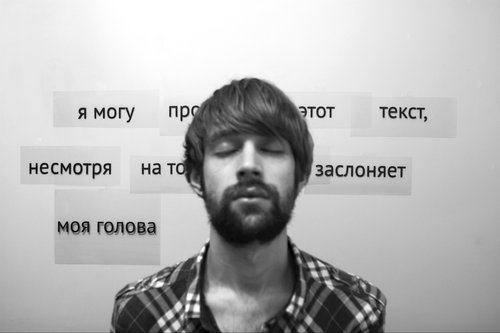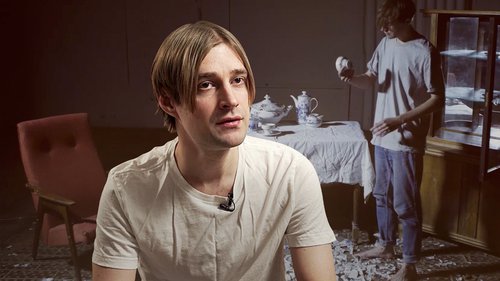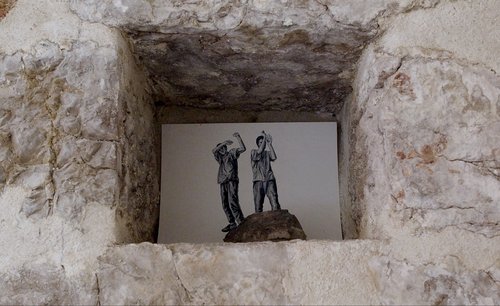Evgeny Granilshchikov. Landscapes of the end of the world. Courtesy of Anna Nova Gallery
Granilshchikov’s Revolutionary Romanticism Through the Fog
Evgeny Granilshchikov's first solo exhibition in St Petersburg, ‘Mist’ is currently on view at the Anna Nova gallery in St Petersburg featuring videos, photography, works on paper and objects. Curated by Viktor Misiano, the show explores themes of displacement, trauma and community loss through a romantic lens.
Evgeny Granilshchikov (b. 1985) is one of the outstanding artists of his generation with an impressive art career both at home in Russia and abroad. A graduate of the Rodchenko School, in 2010–2013 he studied under photographer Igor Mukhin (b. 1961). As early as 2014, his film ‘The Burial of Courbet’ – an 11-minute collage of impressions from February, March and April which he shot on a telephone – became a notable event and was shown in the Main Project of the fourth Moscow International Biennale of Contemporary Art curated by David Elliott and in the competition programme of the Kino Der Kunst festival in Munich. A follower of Jean-Luc Godard, Granilshchikov is undoubtedly a political artist, as far as open and direct observation can be a political statement (looking at the older generation of artists, such truthful impassivity of photographic fixation was reflected in the painting of the hyperrealist Semyon Faibisovich (b. 1949), who also worked with telephone imagery). Granilshchikov is an artist who captured an accurate picture of life in Moscow in the 2010s.
Mist’ is the artist's first solo exhibition in St Petersburg and his inaugural collaboration with the Anna Nova gallery. Like many other projects of recent years in Russia, this one has been made “in the artist's absence”, which, unfortunately, has become a familiar exhibition genre: since 2022, Granilshchikov has been living in France, and is currently taking part in an artist residency in China. For the St Petersburg gallery exhibition, renowned curator Viktor Misiano has used the artist’s solo show Lacune – held in April 2025 at the Chapelle de l’Ancien Hôpital Général in Clermont-Ferrand – as its foundation. At Anna Nova, the artist presents a cohesive group of recent videos, photographs, works on paper and objects.
The title of the project, ‘Mist’, an important image in Granilshchikov’s art generates a chain of associations. In his text, the artist evokes mist in eight poetic metaphors, for example: “Mist is memory that has lost its outlines; it is a future that has not yet taken shape.” Viktor Misiano expands on the cultural connotations of mist, from “Mist blurs the contrast of binary oppositions” to “The boundary between art and life is shrouded in mist and becomes indistinguishable.” One is reminded here of the video work Defence (2007) by the art group Blue Soup, in which machine-gun bursts crackle for ten minutes through a dense, drifting fog.
For Granilshchikov mist expresses doubt. One of the works in the photo-triptych ‘New Series’, where trees drowning in thick fog are photographed, contains the caption: “I am really trying not to see this as a metaphor.” He often presents photographs as frames from imaginary films with non-existent subtitles.
In the three-channel video Untitled, the artist dances at length, absorbed in a duet with a sheet of paper, one side painted black. In his hands, the dense, weighty sheet takes on many roles, shifting from infant to partner, until, in the finale, it is torn to pieces, unable to withstand the force of his leaps and gestures. Opposite the video hangs a series of twelve graphic works, A Tale of Darkness – monochrome drawings in black ink accompanied by short texts, such as: “Sometimes darkness turned into action, action without words.”
Misiano explains the emergence of a substantial graphic corpus in Granilshchikov’s practice – where video remains the dominant medium – in a conversation with Art Focus Now: “He began working on drawings in such quantity simply because he was settling in. There wasn’t yet the social or communicative infrastructure to start producing cinema.” He goes on: “He began learning English, and the texts in his drawings and photographic works come directly from notebooks where he copied out certain words or simply did language exercises, using the work as a pretext to try writing something in English. He rejected an entire series of drawings once he realised the text on them was written incorrectly.”
In two other video performances – ‘Heritage’ and ‘Heritage II’ – the artist continues storylines in video works from 2021–2022. Then he was ridding himself of the past, systematically smashing porcelain crockery from the dresser in his parents’ house (‘Family Porcelaine’, 2021), now he dances barefoot on the shards or washes them and tries to put them together. Viktor Misiano notes in conversation: “All the works that we see here are the result of trauma, the loss of community. Granilshchikov very keenly feels himself to be an artist of his generation, an expresser of its mentality, ideals, hopes and disappointments.”
In Tulips, a photograph of a laid table with a vase of tulips – rendered in the instantly recognisable colour palette of 1950s illustrated magazines – is projected onto the wall. The image is in constant flux as a white curtain, stirred by the air from a fan, drifts through the projector’s beam. This visual trope, typical of the Soviet era, once signified hopes for a happy domestic life and a new way of living. Among artists of the previous generation, such lyrical imagery was developed in depth above all by Dmitry Gutov (b. 1960), author of the celebrated installation Above the Black Mud (1994).
The title ‘Mist’ and the figure of the artist is associated with a famous painting by Caspar David Friedrich (1774–1840) ‘Wanderer Above the Sea of Fog’ (1818) – an icon of Romantic art. Romanticism is the stylistic key to the show at the Anna Nova gallery. As Viktor Misiano noted in conversation, “Romanticism is not so much a device as a certain intention, I would say ‘Stimmung’. A state of spirit with which the artist approaches creativity and expression.” Over recent decades, Romanticism has turned into a stable artistic fashion, returning big ideas and forms to the legitimate sphere of art, and in this, Romantic imagery proved salvific for artists, opposing difficult themes and vivid affects to the widespread plastic and ideological laxity.
Viktor Misiano, beginning with his widely known text from 1999 “The Cultural Contradictions of the Tusovka (Get-Together)”, constantly develops the thought about the importance of community: “If the 1990s were a time of forming rigid communities of artists and direct statements, the 2000s were years of the neo-institutional trend, the desire to fit into the system and its uncritical acceptance, then in the 2010s, and Granilshchikov is their typical representative, we see an artist who is, on the one hand, embedded in ongoing processes and public discussion, and on the other hand, avoids direct statement, wishes to remain on the territory of art and speak from personal, very subjective experience. This is again the creation of community. Romanticism and the romantic are components of a direct desire to preserve faith in art as a certain form of communication, which exists and constantly balances between reality and unreality, but does not want to fall into reality, of which artists of the 1990s dreamed,” he says, and acknowledges in Granilshchikov's art another example of revolutionary Romanticism.
Evgeny Granilshchikov. Mist
St Petersburg, Russia
7 November, 2025 – 11 January, 2026















